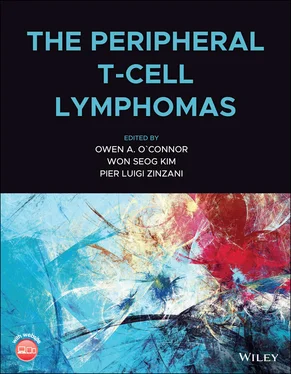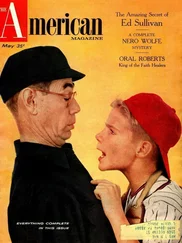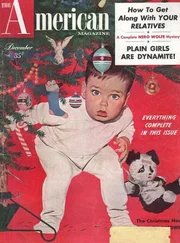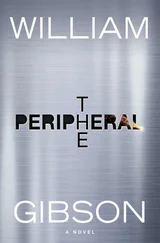61 61 de Leval, L., Rickman, D.S., Thielen, C. et al. (2007). The gene expression profile of nodal peripheral T‐cell lymphoma demonstrates a molecular link between angioimmunoblastic T‐cell lymphoma (AITL) and follicular helper T (TFH) cells. Blood 109 (11): 4952–4963.
62 62 Crotty, S. (2014). T follicular helper cell differentiation, function, and roles in disease. Immunity 41 (4): 529–542.
63 63 Gaulard, P. and de Leval, L. (2014). The microenvironment in T‐cell lymphomas: emerging themes. Semin Cancer Biol 24: 49–60.
64 64 Foss, H., Anagnostopoulos, I., Herbst, H. et al. (1995). Patterns of cytokine gene expression in peripheral T‐cell lymphoma of angioimmunoblastic lymphadenopathy type. Blood 85 (10): 2862–2869.
65 65 Papadi, B., Polski, J.M., Clarkson, D.R., and Liu‐Dumlao, T.O. (2012). Atypical angioimmunoblastic T‐cell lymphomas masquerading as systemic polyclonal B‐immunoblastic proliferation. Virchows Arch 461 (3): 323–331.
66 66 Ohshima, K., Haraoka, S., Suzumiya, J. et al. (2000). Cytoplasmic cytokines in lymphoproliferative disorders: multiple cytokine production in angioimmunoblastic lymphadenopathy with dysproteinemia. Leuk Lymphoma 38 (5–6): 541–545.
67 67 Niino, D., Komohara, Y., Murayama, T. et al. (2010). Ratio of M2 macrophage expression is closely associated with poor prognosis for Angioimmunoblastic T‐cell lymphoma (AITL). Pathol Int 60 (4): 278–283.
68 68 Tripodo, C., Gri, G., Piccaluga, P.P. et al. (2010). Mast cells and Th17 cells contribute to the lymphoma‐associated pro‐inflammatory microenvironment of angioimmunoblastic T‐cell lymphoma. Am J Pathol 177 (2): 792–802.
69 69 Iqbal, J., Weisenburger, D.D., Greiner, T.C. et al. (2010). Molecular signatures to improve diagnosis in peripheral T‐cell lymphoma and prognostication in angioimmunoblastic T‐cell lymphoma. Blood 115 (5): 1026–1036.
70 70 Iqbal, J., Wright, G., Wang, C. et al. (2014). Gene expression signatures delineate biological and prognostic subgroups in peripheral T‐cell lymphoma. Blood 123 (19): 2915–2923.
71 71 Schwartz, F.H., Cai, Q., Fellmann, E. et al. (2017). TET2 mutations in B cells of patients affected by angioimmunoblastic T‐cell lymphoma. J Pathol 242 (2): 129–133.
72 72 Nguyen, T.B., Sakata‐Yanagimoto, M., Asabe, Y. et al. (2017). Identification of cell‐type‐specific mutations in nodal T‐cell lymphomas. Blood Cancer J 7 (1): e516.
73 73 Bräuninger, A., Spieker, T., Willenbrock, K. et al. (2001). Survival and clonal expansion of mutating “forbidden” (immunoglobulin receptor‐deficient) epstein‐barr virus‐infected b cells in angioimmunoblastic t cell lymphoma. J Exp Med 194 (7): 927–940.
74 74 Cheminant, M., Bruneau, J., Kosmider, O. et al. (2015). Efficacy of 5‐Azacytidine in a TET2 mutated angioimmunoblastic T cell lymphoma. Br J Haematol 168 (6): 913–916.
75 75 Tiacci, E., Venanzi, A., Ascani, S. et al. (2018). High‐risk clonal hematopoiesis as the origin of AITL and NPM1‐mutated AML. N Engl J Med 379 (10): 981–984.
76 76 Lemonnier, F., Dupuis, J., Sujobert, P. et al. (2018). Treatment with 5‐azacytidine induces a sustained response in patients with angioimmunoblastic T‐cell lymphoma. Blood 132 (21): 2305–2309.
77 77 Lamant, L., McCarthy, K., d’Amore, E. et al. (2011). Prognostic impact of morphologic and phenotypic features of childhood ALK‐positive anaplastic large‐cell lymphoma: results of the ALCL99 study. J Clin Oncol 29 (35): 4669–4676.
78 78 Geissinger, E., Odenwald, T., Lee, S.S. et al. (2004). Nodal peripheral T‐cell lymphomas and, in particular, their lymphoepithelioid (Lennert's) variant are often derived from CD8(+) cytotoxic T‐cells. Virchows Arch 445 (4): 334–343.
79 79 Patsouris, E., Engelhard, M., Zwingers, T., and Lennert, K. (1993). Lymphoepithelioid cell lymphoma (Lennert's lymphoma): clinical features derived from analysis of 108 cases. Br J Haematol 84 (2): 346–348.
80 80 Ballester, B., Ramuz, O., Gisselbrecht, C. et al. (2006). Gene expression profiling identifies molecular subgroups among nodal peripheral T‐cell lymphomas. Oncogene 25 (10): 1560–1570.
81 81 Cuadros, M., Dave, S.S., Jaffe, E.S. et al. (2007). Identification of a proliferation signature related to survival in nodal peripheral T‐cell lymphomas. J Clin Oncol 25 (22): 3321–3329.
82 82 Aggarwal, D., Srivastava, G., Gupta, R. et al. (2012). Angiogenesis in non‐Hodgkin's lymphoma: an intercategory comparison of microvessel density. ISRN Hematol 2012: 943089.
83 83 Rabenhorst, A., Schlaak, M., Heukamp, L.C. et al. (2012). Mast cells play a protumorigenic role in primary cutaneous lymphoma. Blood 120 (10): 2042–2054.
84 84 Zhang, W., Wang, L., Zhou, D. et al. (2011). Expression of tumor‐associated macrophages and vascular endothelial growth factor correlates with poor prognosis of peripheral T‐cell lymphoma, not otherwise specified. Leuk Lymphoma 52 (1): 46–52.
85 85 Rafii, S., Lyden, D., Benezra, R. et al. (2002). Vascular and haematopoietic stem cells: novel targets for anti‐angiogenesis therapy? Nat Rev Cancer 2 (11): 826–835.
86 86 Tabbò, F., Ponzoni, M., Rabadan, R. et al. (2013). Beyond NPM‐anaplastic lymphoma kinase driven lymphomagenesis: alternative drivers in anaplastic large cell lymphoma. Curr Opin Hematol 20 (4): 374–381.
87 87 Salven, P., Orpana, A., Teerenhovi, L., and Joensuu, H. (2000). Simultaneous elevation in the serum concentrations of the angiogenic growth factors VEGF and bFGF is an independent predictor of poor prognosis in non‐Hodgkin lymphoma: a single‐institution study of 200 patients. Blood 96 (12): 3712–3718.
88 88 Ganjoo, K., Hong, F., Horning, S.J. et al. (2014). Bevacizumab and cyclosphosphamide, doxorubicin, vincristine and prednisone in combination for patients with peripheral T‐cell or natural killer cell neoplasms: an Eastern Cooperative Oncology Group study (E2404). Leuk Lymphoma 55 (4): 768–772.
89 89 Roufosse, F., Garaud, S., and de Leval, L. (2012). Lymphoproliferative disorders associated with hypereosinophilia. Semin Hematol 49 (2): 138–148.
90 90 Kleinhans, M., Tun‐Kyi, A., Gilliet, M. et al. (2003). Functional expression of the eotaxin receptor CCR3 in CD30+ cutaneous T‐cell lymphoma. Blood 101 (4): 1487–1493.
91 91 Lacy, P. and Moqbel, R. (2000). Eosinophil cytokines. Chem Immunol 76: 134–155.
92 92 Poiesz, B.J., Ruscetti, F.W., Gazdar, A.F. et al. (1980). Detection and isolation of type C retrovirus particles from fresh and cultured lymphocytes of a patient with cutaneous T‐cell lymphoma. Proc Natl Acad Sci U S A 77 (12): 7415.
93 93 Matsuoka, M. (2003). Human T‐cell leukemia virus type I and adult T‐cell leukemia. Oncogene 22 (33): 5131–5140.
94 94 Bangham, C.R.M. (2018). Cell leukemia virus type 1: persistence and pathogenesis. Annu Rev Immunol 36: 43–71.
95 95 Bangham, C.R.M. and Ratner, L. (2015). How does HTLV‐1 cause adult T‐cell leukaemia/lymphoma (ATL)? Curr Opin Virol 14: 93–100.
96 96 Melamed, A., Laydon, D.J., Gillet, N.A. et al. (2013). Genome‐wide determinants of proviral targeting, clonal abundance and expression in natural HTLV‐1 infection. PLOS Pathogens 9 (3): e1003271.
97 97 Watanabe, T. (2017). Adult T‐cell leukemia: molecular basis for clonal expansion and transformation of HTLV‐1‐infected T cells. Blood 129 (9): 1071–1081.
98 98 Tabiasco, J., Vercellone, A., Meggetto, F. et al. (2003). Acquisition of viral receptor by NK cells through immunological synapse. J Immunol 170 (12): 5993.
99 99 Lee, J.H., Choi, J., Ahn, Y.O. et al. (2018). CD21‐independent Epstein‐Barr virus entry into NK cells. Cell Immunol 327: 21–25.
100 100 Morales‐Sánchez, A. and Fuentes‐Pananá, E.M. (2014). Human viruses and cancer. Viruses 6 (10): 4047–4079.
Читать дальше












